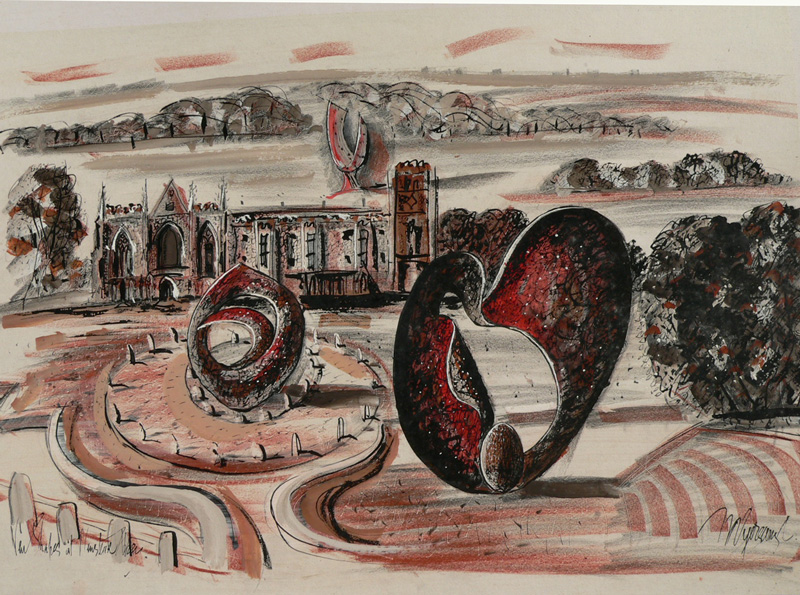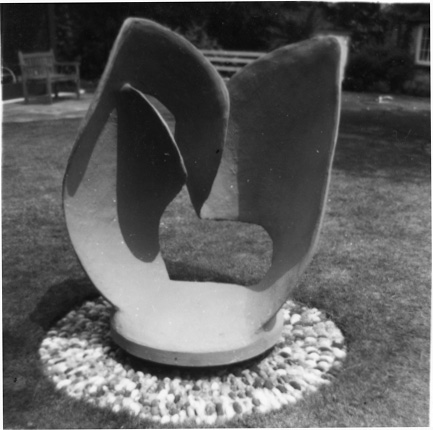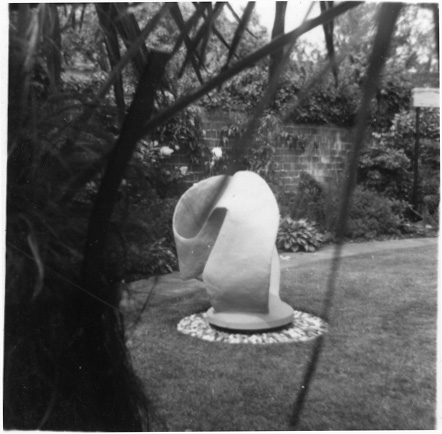Raymond Myerscough-Walker (1908-1984)
New Sculpture at Newstead Abbey, c.1970s
Click on the image for a larger picture

|
Inks, bodycolour and sanguine conte
Signed: Myerscough
Inscribed: New Shapes at Newstead Abbey
Numbered au verso: 1301
44 x 63.5 cms
Price: please apply to jbl@gallerylingard.com
Newstead Abbey is most widely known as the former home of the poet Lord Byron. The building was originally an Augustinian priory founded by Henry II around 1170 where a small religious community lived until the monastery was dissolved by Henry VIII in 1539. Newstead was granted to Sir John Byron in 1540 who turned the priory into a private home for his family and it remained a family property through sale and purchase of various owners until Sir Julien Cahn subsequently presented the estate to Nottingham Corporation in 1931.
Myerscough-Walker's view of Newstead Abbey shows the West Front from across the parkland, a view reminiscent of the 1730 painting by Peter Tillemans. Qualified as an architect and much sought-after as an architectural draughtsman between the 1920s-1940s, Myerscough choice of Newstead as a subject is unsurprising, But what interests Myerscough here is the 'surreal' dynamic of introducing modern 20th century sculpture into an historic rural setting; where Tilleman's view of Newstead records a Gothic monument as the central feature of the turning circle, Myerscough substitutes the monument with a contemporary sculptural form of his own design in front of the Abbey, together with two more 'monocoques' in the surrounding parkland. Myerscough had become acquainted with surealism through Paul Nash and John Tunnard whilst living in Chelsea in the 1930s. By the late 1940s he had become disenchanted with the condition of architecture in Britain and after the war he left London to live in primitive isolation on the Sussex Downs, 'dropping-out' long before it became fashionable to do so. Under the name of 'Myerscough' he began to paint in ernest, experimenting with surreal combinations of architecture, sculptural forms and landscape. He developed a fascination with the 'monocoque', a self-supporting structure, making models of them and painting their forms in various settings, as he does here in 'New Shapes at Newstead Abbey'. The surreal combination of the monocoque form and historic Newstead setting offers a refreshingly new and subjective response to an otherwise familiar subject.
For his patron Charles Kearsley Myerscough created large pieces of sculpture in the 1970s and these were placed in the garden at Langstone Harbour in Sussex (see illustrations below). In 1976 Kearsley commissioned the architect John Lomax to build him a new house at Hathill on the Goodwood Estate, and Myerscough's sculpture found a new site in the gardens there. More recently, and inspired by the precedent set by Kearsley and Myerscough, the Cass Sculpture Foundation was created at Hathill to promote and sell "the best outdoor sculpture from today's leading British artists", including Anthony Caro and Thomas Heatherwick. This followed the lead taken by earlier sculptors such as Barbara Hepworth and Henry Moore who had already found rural sites to be a creative environment for their work (sculpture gardens were formed by Hepworth at Trewyn Studios, Cornwall, now the Hepworth Museum and Henry Moore at Perry Green in Hertfordshire, now the Henry Moore Foundation).
Myerscough's 'Monocoque Sculpture' for Charles Kearsley at Langstone Harbour, c.1975


Myerscough-Walker was an extraordinary individual: architect, perspectivist, artist, sculptor, journalist, author and stage designer. He was renowned as one of the best architectural draughtsmen of the 1920s-1940s working for architects as diverse as Edwin Lutyens and modernist Berthold Lubetkin. He developed a 'subjective' and idiosyncratic method of working which he described in detail in his book The Perspectivist published in 1958. His distinctive style developed under the guidance of two teachers at the Architectural Association, John Holmes and Walpole Champneys, as well as his familiarity with contemporary artists such as Graham Sutherland and John Piper. Myerscough hoped that "... subjective architectural drawing ..." might lead to a more independent creative expression for architectural artists who were, otherwise, obliged to adopt the manner chosen by the client. His work is essentially dramatic and expressive, often with fantastic trees and foreboding skies that create a dynamic setting for depicting buildings. His use of bodycolour rather than wash, graphite rather than pencil and experimentation with wax crayon, sanguine conte and glazes created artworks of great individuality.
Raymond was born in Yorkshire in 1908 and began his architectural education working in Leeds for an architect in 1926 whilst attending the Leeds School of Art. He received a scholarship award and went on to study at the Architectural Association in London from 1928. Myerscough led a bohemian life in London which distracted him from his studies but he was re-admitted to the AA course and won the Tite Prize in 1931 for his work. This was the year he joined the office of Louis de Soissons and Grey Wornum but he rejected the idea of working in an architects' office and decided instead to set up on his own account as a freelance architect, draughtsman and artist. He began to draw perspectives for other architects who, recognising his distinct and expressive manner of drawing, brought him a good deal of work. By 1934 Myerscough had moved to Chelsea where he enjoyed an irregular life rubbing shoulders with Graham Sutherland and surrealist artists of the time. Sir John Summerson remembered him as a "... roguish character with a strong liking for girls. He used to draw like an angel ... ". His interest in Bauhaus ideals at this time is reflected in his design for a Sunhouse for R T Grange, completed in 1937. After the war he left London to work in primitive isolation on the Sussex Downs, 'dropping-out' of the artistic scene in London. This was one of the most productive periods for him, painting, sculpting and writing. He maintained a most methodical approach to his work.
Apart from his perspective work for architects, Myerscough regularly contributed to the architectural journals; The Builder of 1937 published a number of his articles on drawing. He continued to work as a freelance perspective artist up to the 1950s but then turned more to working as an artist and sculptor, often in abstract form, in quiet seclusion from his caravan near Chichester, Sussex.
